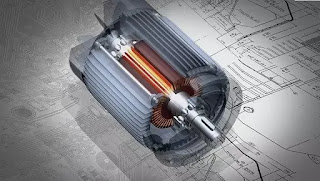BY AFZAL YOUSAF
Electric motor is considered as the HEART of the EVs as is the main motive element. Even though maintenance in electric vehicles especially in motor is very less but faults can occur like any other materials. Main parts of the motor are Stator, Rotor, Bearing, Shaft, Poles, Yoke, electrical connection etc. And possible electric faults that can occur in a motor are:-
- Electrical faults
- Mechanical faults
In Electrical fault, Major faults are Rotor related faults and Stator related faults. And in Mechanical section, usual faults are Bearing faults and Eccentricity-related faults. These faults can be summarised by the location of the fault occurrence. Rate of occurrence of the above faults are shown below in the pie chart.
From above we can see the Bearing faults and Stator related faults are the most common faults in Electric motor. And when we take a deeper look on the specific faults that occurs during these faults are listed below.
- Rotor related faults - In rotor related faults usual faults are Broken rotor bar, Cracked rotor end rings and Shorted rotor field windings.
- Stator related faults - Usual faults occurring in stator are Abnormal connection of stator windings and Open circuit or short circuit of stator windings.
- Bearing faults - In Bearing of the motor, usual faults occurs are Outer and Inner bearing race deflect, Ball deflect and Train deflect.
- Eccentricity related faults - In eccentricity related faults most common faults are Bend shaft, Static air-gap irregularities and Dynamic air-gap irregularities.
These are the most common faults that can occur in Electric motor. Several studies have been done to investigate the fault signatures of electric motor in the past decades. The faults needs to be diagnosed on time and corrected for the proper working of EVs. Common faults diagnostic techniques proposed for the Electric motor are listed below.
- Motor current signature analysis
- Mechanical vibration analysis
- Temperature measurement
- Oil and gas analysis
Motor current signature analysis
Motor current signature analysis is the most common tool for fault diagnosis in electric motor. For the analysis in this technique Digital signal processor techniques are used. And fault approaches for Rotor and stator is different and briefed below.
Rotor-related fault diagnostic approaches can be broadly listed as follows.
- Fast Fourier Transformer (FFT) spectrum analyzer.
- Reference frame theory analysis (RFTA)
- Time and frequency domain analysis.
- Time-stepping coupled finite element state space method.
- State and parameter estimation techniques.
When broken rotor bar faults occur RFTA and FFT performs frequency spectrum analysis and compare the results of motor line current. It is observed in the expiriment that both RFTA and FFT illustrate explicit harmonic component in stator current and the magnitudes tested by RFTA are nearly the same as the FFT spectrum analyzer outputs. But RFTA can clearly be able to indicate the current magnitude at certain frequency. Time and Frequency domain analysis shows how a signal changes over time and frequencies.
Stator related faults diagnostics are:-
- Flux based detection.
- Power decomposition technique.
- Statistical process control.
- Concordia pattern recognition.
Flux based detection is a new method based on the analysis of the air gap flux search coil voltage during motor starting is proposed for reliable detection and classification of rotor cage, eccentricity, and mechanical defects in the load. And remaining mentioned techniques are also advanced to diagnose the stator faults.
Mechanical Vibration analysis
Mechanical vibration analysis is mainly used to detect Bearing failure. Major techniques are:-
- Envelop detection technique.
- Artificial neural networks.
- Vibration spectrum analysis.
The basic idea of bearing fault diagnosis relies on the vibration spectrum analysis. There are four types of bearing faults which are the main sources of motor vibration, namely outer race defect, inner race defect, ball defect, and train defect. Each defect type has its unique vibration frequency component. The traditional vibration spectrum analysis has the shortcoming of low accuracy in detecting defect frequency components. Envelop detection technique is improved in efficiency and accuracy by using band pass filter and Hilbert transform. It detects power spectrum instead of traditional current spectrum.
Temperature Measurement
Temperature measurement in fault detection is widely applied for the detection of short turn faults by using pattern recognition algorithm . Temperature is used as the fault indicator for open or short circuit in motor winding and wiring insulation failures.
A simplified thermal model of induction motor is implemented by comparing the heating results between the normal motor and the motor of short-circuit fault. It shows that short-circuit fault could result in additional losses that behave in thermal signatures.
Oil and Gas Analysis
This method is the analysis of oil and gas sample from the motor. The sample is taken from fully operating model and analysed in the lab. In the lab, key characteristics of the oil is studied and finds the fault.
As a Summary we can say that Motor current analysis, Vibration analysis and Temperature analysis are widely used for motor fault diagnoses. Motor current analysis has the advantage of cost-effective compared with other techniques.
Credits:- Journal of Asian electric vehicles and authors.
Comment your queries and thoughts on the topic. Keep Reading.








Comments
Post a Comment
Please do not enter any spam link in the comment box.